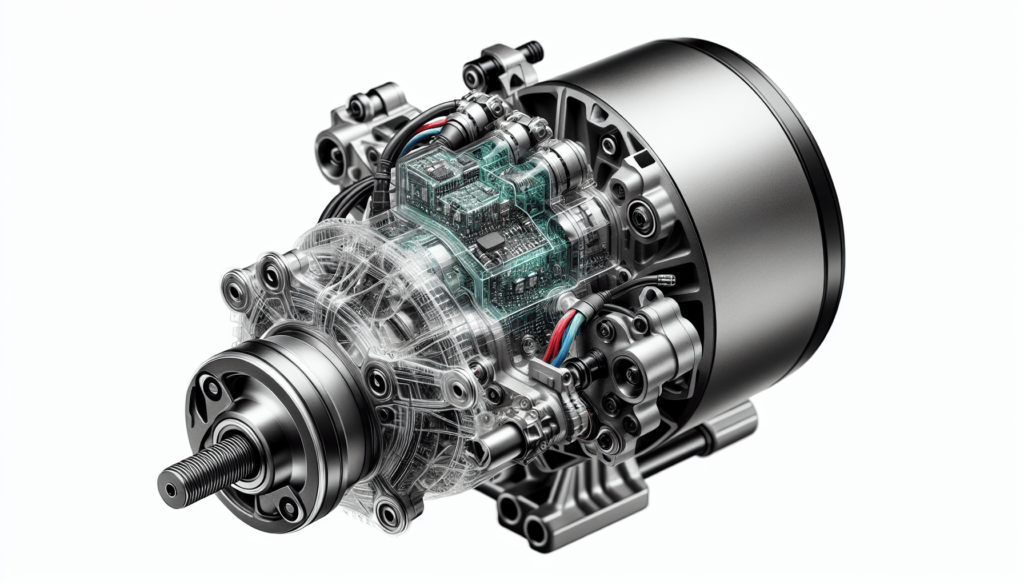In this article, you will learn how to effectively fix a motor position sensor fault on your ebike. If you’re experiencing issues with your motor, specifically related to the position sensor, don’t worry! We’ve got you covered. With our easy-to-follow steps and friendly guidance, you’ll be back on the road enjoying your ebike in no time. Say goodbye to frustrating sensor faults and hello to a smooth and enjoyable ride. So, let’s get started and get your motor back on track!
Diagnosing the Motor Position Sensor Fault
Understanding the Function of the Motor Position Sensor
The motor position sensor is a vital component of an e-bike’s motor system. Its primary function is to provide feedback to the e-bike’s computer system, allowing it to accurately determine the exact position of the motor’s rotor. This information is essential for proper motor performance, including effective torque control and precise handling.
Identifying Symptoms of a Motor Position Sensor Fault
If your e-bike is experiencing a motor position sensor fault, there are several common symptoms you may notice. These can include erratic motor behavior, such as sudden power loss, inconsistent acceleration, or difficulty maintaining a consistent speed. You may also experience issues with the e-bike’s display, such as incorrect readings or error messages related to the motor position sensor. It is important to pay attention to these symptoms, as they may indicate a faulty motor position sensor that needs to be addressed.
Performing Basic Troubleshooting Checks
Before diving into more advanced diagnostics and repairs, it is always a good idea to start with basic troubleshooting checks. Make sure to inspect the wiring connections for any loose or damaged wires. Check the battery voltage to ensure it is within the recommended range. Additionally, reviewing the e-bike’s computer system for any available firmware updates is crucial, as outdated firmware can sometimes contribute to motor position sensor faults. These basic checks can help identify any simple fixes before moving on to more complex tasks.
Inspecting and Cleaning the Sensor
Locating the Motor Position Sensor
To begin the inspection and cleaning process, you first need to locate the motor position sensor on your e-bike. The sensor is typically mounted near the motor and is connected to the wiring harness. Refer to your e-bike’s user manual or consult the manufacturer’s website for specific information on the sensor’s location in your model.
Removing the Sensor Cover
Once you have located the motor position sensor, carefully remove the sensor cover. This can usually be done by unscrewing the cover plate or removing any clips or retaining screws. Take note of the correct orientation of the sensor and its cover for proper reinstallation later on.
Cleaning the Sensor
With the sensor cover removed, you will now be able to access the motor position sensor. The sensor’s surface may accumulate dirt, debris, or other contaminants over time, affecting its performance. Gently clean the sensor using a non-abrasive cloth or a specialized electronics cleaning solution. Avoid using water or harsh chemicals that may damage the sensor. Ensure that the sensor is completely dry before proceeding with further testing or repairs.

Testing the Sensor Continuity
Using a Multimeter
Testing the continuity of the motor position sensor is an essential step in diagnosing any faults accurately. To perform this test, you will need a multimeter, which is a versatile tool used for measuring electrical properties. Set the multimeter to the continuity testing mode and carefully connect its probes to the appropriate terminals of the motor position sensor.
Checking the Sensor Wiring
Before testing the sensor continuity, it is crucial to check the sensor wiring for any signs of damage or poor connections. Inspect the wiring harness for any frayed insulation, loose connections, or breaks. Addressing any faults in the wiring is essential before proceeding with the sensor continuity test.
Testing the Sensor Continuity
With the multimeter properly connected and the sensor wiring in good condition, you can now proceed with testing the sensor continuity. Activate the multimeter’s continuity mode and carefully touch the probes to the sensor terminals. If there is proper continuity, the multimeter should emit a beep or indicate a closed circuit. If there is no continuity or inconsistent readings, it is likely that the sensor is faulty and needs to be replaced.
Replacing the Faulty Sensor
Identifying the Suitable Replacement Sensor
If the motor position sensor is determined to be faulty, you will need to find a suitable replacement. Refer to your e-bike’s user manual or reach out to the manufacturer for information on compatible sensor models. It is crucial to ensure that the replacement sensor matches the specifications and requirements of your e-bike’s motor system.
Removing the Old Sensor
To replace the faulty motor position sensor, you will first need to remove the old sensor. This can usually be accomplished by carefully disconnecting the wiring harness and removing any retaining screws or clips holding the sensor in place. Take note of the sensor’s position and orientation during removal to ensure proper installation of the new sensor.
Installing the New Sensor
Once the old sensor is removed, carefully install the new motor position sensor in its place. Ensure that the sensor is correctly aligned and properly secured with retaining screws or clips. Reconnect the wiring harness, taking care to match the correct terminals. Double-check the connections and make sure they are secure before moving on to the next steps.

Calibrating the Sensor
Understanding the Importance of Calibration
After replacing the motor position sensor, it is crucial to calibrate it properly to ensure accurate motor performance. Calibration involves synchronizing the sensor with the e-bike’s computer system, allowing it to accurately detect the rotor’s position. Failing to calibrate the sensor may result in erratic motor behavior or inaccurate readings.
Following Manufacturer’s Calibration Instructions
Calibrating the motor position sensor should be done following the specific instructions provided by the e-bike manufacturer. These instructions can typically be found in the user manual or on the manufacturer’s website. Ensure that you carefully follow each step and make any necessary adjustments as instructed.
Testing the Sensor After Calibration
After completing the calibration process, it is important to test the sensor to ensure its proper functioning. Take the e-bike for a short ride, paying close attention to the motor’s performance. Monitor for any irregularities or issues that may indicate improper sensor calibration. If everything appears to be functioning correctly, you can proceed with further checks to ensure the overall health of your e-bike’s system.
Checking the E-Bike’s Computer System
Verifying the Battery Voltage
To ensure the optimal performance of your e-bike’s motor system, it is essential to regularly check the battery voltage. A low or fluctuating battery voltage can affect the accuracy and reliability of the motor position sensor. Use a voltmeter or consult the e-bike’s display to verify that the battery voltage is within the recommended range. If the voltage is outside the acceptable limits, address any battery issues promptly.
Inspecting the ECU Connections
The ECU (Electronic Control Unit) is a crucial component of an e-bike’s computer system that communicates with various sensors, including the motor position sensor. Inspect the ECU connections for any signs of damage, loose connections, or corrosion. Clean any dirty connections and ensure they are secure. Poor ECU connections can lead to sensor faults and other system malfunctions.
Checking for Firmware Updates
Just like any other electronic device, e-bikes may receive firmware updates from the manufacturer. These updates often address known issues, including motor position sensor faults. Regularly check the manufacturer’s website for any available firmware updates specific to your e-bike model. Following the instructions provided, update the firmware as necessary to ensure the optimal performance of your e-bike’s computer system.
Consulting the E-Bike Manufacturer or Technician
Contacting E-Bike Manufacturer’s Support
If you are experiencing persistent motor position sensor faults or are unsure about any aspect of the diagnostic and repair process, it is always advisable to contact the e-bike manufacturer’s support. They can provide valuable guidance, answer any questions, and assist in troubleshooting more complex issues that may require professional attention.
Seeking Assistance from a Professional Technician
If you are unable to resolve the motor position sensor fault on your e-bike or lack the necessary technical knowledge and tools, it may be necessary to seek assistance from a professional e-bike technician. They have the expertise to diagnose and repair a wide range of e-bike issues, including motor position sensor faults. Contact reputable e-bike repair shops or authorized service centers to ensure quality assistance.
Following Manufacturer’s Approved Procedures
When seeking professional assistance or if instructed by the e-bike manufacturer, it is important to follow their approved procedures for handling motor position sensor faults. This includes choosing authorized repair centers or technicians and ensuring that genuine replacement parts are used. Following these procedures helps protect your e-bike’s warranty while ensuring accurate and long-lasting repairs.
Preventing Future Motor Position Sensor Faults
Regular Maintenance and Inspection
To help prevent motor position sensor faults in the future, it is crucial to implement a regular maintenance and inspection routine. Follow the maintenance recommendations provided by the e-bike manufacturer, including regular cleaning, lubrication, and checking for any signs of wear or damage to the motor position sensor and its wiring. Address any issues promptly to avoid potential faults.
Avoiding Extreme Weather Conditions
Extreme weather conditions, such as heavy rain, extreme heat, or freezing temperatures, can adversely affect the performance and longevity of your e-bike’s motor position sensor. Whenever possible, avoid exposing your e-bike to these conditions. If riding in adverse weather is unavoidable, take extra precautions to protect the motor position sensor and other sensitive components from direct exposure.
Proper Handling and Storage
Properly handling and storing your e-bike can also contribute to the prevention of motor position sensor faults. Avoid dropping or mishandling the bike, which can cause damage to the sensor and its connections. When storing your e-bike, choose a dry and secure location that is protected from extreme temperatures and humidity. Use a bike cover or protective bag if necessary.
Conclusion
Diagnosing and fixing a motor position sensor fault on your e-bike is crucial for ensuring optimal performance and reliability. By understanding the function of the sensor, identifying symptoms, and following the steps outlined in this article, you can effectively diagnose and address motor position sensor faults. Regular maintenance, proper handling, and adhering to manufacturer’s guidelines will also play a key role in preventing future sensor faults. Remember, if you encounter any difficulties or uncertainties during the process, don’t hesitate to reach out to the e-bike manufacturer’s support or consult a professional e-bike technician for assistance.


